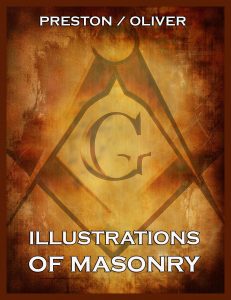Illustrations Of Masonry – Preston/Oliver
This Tract is divided into Four Books. In the First Book, the excellency of Masonry is displayed.In the Second Book the general plan of the subjects treated in the three Degrees is illustrated, with occasional remarks; and a brief description is given of the ancient ceremonies of the Order. This part of the Treatise, which the Author considers most essential for the instruction and improvement of his brethren, is considerably extended in the later Editions. The Third Book contains the copy of a curious old Manuscript on Masonry, with annotations, the better to explain this authentic document of antiquity. The Fourth Book is restricted to the history of Masonry from its first appearance in England, to the year 1812, in which are introduced the most remarkable occurrences of the Society, both at home and abroad, with some account of the principal Patrons and Protectors of the Fraternity at different periods.

Illustrations Of Masonry
Format: Paperback.
Illustrations Of Masonry.
ISBN: 9783849676162.
Available at amazon.com and other venues.
Basics of Freemasonry (from wikipedia.com)
Freemasonry or Masonry consists of fraternal organisations that trace their origins to the local fraternities of stonemasons, which from the end of the fourteenth century regulated the qualifications of stonemasons and their interaction with authorities and clients. The degrees of freemasonry retain the three grades of medieval craft guilds, those of Apprentice, Journeyman or fellow (now called Fellowcraft), and Master Mason. These are the degrees offered by Craft (or Blue Lodge) Freemasonry. Members of these organisations are known as Freemasons or Masons. There are additional degrees, which vary with locality and jurisdiction, and are usually administered by different bodies than the craft degrees.
The basic, local organisational unit of Freemasonry is the Lodge. The Lodges are usually supervised and governed at the regional level (usually coterminous with either a state, province, or national border) by a Grand Lodge or Grand Orient. There is no international, worldwide Grand Lodge that supervises all of Freemasonry; each Grand Lodge is independent, and they do not necessarily recognise each other as being legitimate.
Modern Freemasonry broadly consists of two main recognition groups. Regular Freemasonry insists that a volume of scripture is open in a working lodge, that every member profess belief in a Supreme Being, that no women are admitted, and that the discussion of religion and politics is banned. Continental Freemasonry is now the general term for the “liberal” jurisdictions who have removed some, or all, of these restrictions.
(The text of the last section was taken from a Wikipedia entry and is available under the the Creative Commons Attribution-ShareAlike License.)
Publisher’s Note: This book is printed and distributed by Createspace a DBA of On-Demand Publishing LLC and is typically not available anywhere else than in stores owned and operated by Amazon or Createspace.
